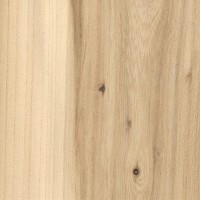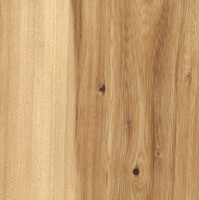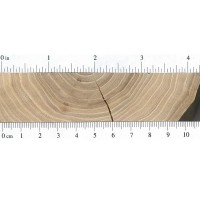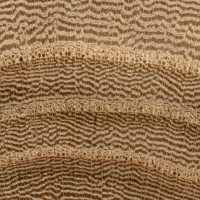 |
Common Name(s): American Elm, Soft Elm, Water Elm Scientific Name: Ulmus americana Distribution: Eastern to Midwest United States Tree Size: 65-100 ft (20-30 m) tall, 2-3 ft (.6-1 m) trunk diameter Average Dried Weight: 35 lbs/ft3 (560 kg/m3) Specific Gravity (Basic, 12% MC): .47, .56 Janka Hardness: 830 lbf (3,690 N) Modulus of Rupture: 11,800 lbf/in2 (81.4 MPa) Elastic Modulus: 1,340,000 lbf/in2 (9.24 GPa) Crushing Strength: 5,520 lbf/in2 (38.1 MPa) Shrinkage: Radial: 4.2%, Tangential: 9.5%, Volumetric: 14.6%, T/R Ratio: 2.3 |
Color/Appearance: Heartwood is light to medium reddish brown. Paler sapwood is usually well defined.
Grain/Texture: Grain is interlocked (making it very resistant to splitting). With a somewhat coarse, uneven texture.
Endgrain: Ring-porous; large to very large earlywood pores in a continuous row one or two pores wide, small latewood pores in wavy bands; tyloses occasionally present in earlywood; growth rings distinct; parenchyma vasicentric and confluent; medium rays, spacing normal.
Rot Resistance: Rated as non-durable; susceptible to insect attack. Living trees are susceptible to Dutch elm disease.
Workability: Can be a challenge to work because of interlocked grain, especially on quartersawn surfaces. Planing can cause tearout and/or fuzzy surfaces. Poor dimensional stability. Glues, stains, and finishes well. Responds well to steam bending, and holds nails and screws well.
Odor: Elm usually has a strong, unpleasant smell when green; though once dried has very little odor.
Allergies/Toxicity: Although severe reactions are quite uncommon, Elm in the Ulmus genus has been reported as a sensitizer. Usually most common reactions simply include eye and skin irritation. See the articles Wood Allergies and Toxicity and Wood Dust Safety for more information.
Pricing/Availability: Should be moderately priced, though availability from mature trees has been greatly diminished by Dutch elm disease.
Sustainability: This wood species is not listed in the CITES Appendices or on the IUCN Red List of Threatened Species.
Common Uses: Boxes, baskets, furniture, hockey sticks, veneer, wood pulp, and papermaking.
Comments: Once one of the largest and most prevalent of the North American elm species, preferred as an ideal shade tree for urban roadsides. American Elm is especially susceptible to Dutch elm disease, and was ravaged by the fungal disease in the second half of the twentieth century. Because the tree is fast growing and bears seeds at a young age, it has been able to continue in areas where older trees have died, though the newer elms also succumb to the disease at a relatively young age. Consequently, large and mature American Elms are uncommon. Many disease-resistant cultivars and hybrids are being used to replace trees killed by Dutch elm disease.
Scans/Pictures: Shown below is a piece of lumber from a small tree that was killed by Dutch elm disease. Being so young, there was very little heartwood formed yet, (the darker brown wood on the right half), with the majority of the wood being sapwood (light area on the left half of the scans).








I cut down a small tree in some dense woods that I thought I had ID’d as an invasive chinaberry. I hauled a log home and tried to stick a sharp axe in the endgrain and it bounced right off . Now I think I may have accidentally got an elm. However, the fresh cut wood doesn’t smell the least bit unpleasant, it’s actually got a quite sweet, slightly vegetal smell. Any ideas are appreciated.
Hello, I sawed down an elm of mine after 32 years ..too big and close to the house and neighbor.. I think it,s an elm as it stank once I sawed it down..for 2 weeks ! Am making coffee tables with the logs. But I noticed a half inch canary yellow ring around the edge and cant seem to sand it off,,like I highlited the whole circumference..the sides are sanded but have no grain ,just light yellow and dark yellow at certain places.. discouraging. And I dont dare put my linceed oil as it might become a big yellow blob… Read more »
Use black locust. It’s much harder and the most durable wood I have ever seen
Right , locust makes great fence post. Turns real pretty too .
I have some 5ftx12ft long slabs of elm I milled. It was outside on blocks for about 2 years before milling. It held up just fine. I was thinking of making an outdoor sign for my company. Would it hold up or just rot to hell? I’d probably finish it with several coats of Waterlox Marianne varnish. Can’t find any info on elm outdoor furniture
You would need to seal all sides of it with an outdoor poly or hemp oil at a very minimum. Not rot resistant at all
Elm it’s not the type of wood to go bad so easy … very hard wood and beautiful as well in my opinion.
I work with wood for 31 years
In direct ground contact, it will inevitably rot, especially endgrain slices. But if you throughly coat BOTH ends in some sort of finish (as many coats as practical), it should give you a little bit longer. I like the gravel/sand idea; I wonder if you could just place them directly on gravel to help dry out the underside faster after rainfall?
I have been making tool boxes and cabinets from oak and ash. For drawer fronts I like to use elm because of its beautiful grain.
The Texas Elm will dull a sharp chainsaw quickly! Splinting even w/a power splitter is very difficult. Next to oak, its the most prolific tree on my e. Texas farm. Toughest wood I ever encountered. Tried to sell a log to the local sawmill, he said it was too hot to saw elm right now, (August), no further explination.
IF YOU HAVE THE SPACE ON YOUR PROPITY CUT THE TREE DOWN PUT 6X6 TIMBERS 2 EVERY 5FT TO 10FEET FROM EVERY SET OF 2TIMBERS WITH A 12T016INCH SPACE BETWEEN EACH SET OF TWO AND BUILD A BOX A ROUND THE TREE OR GET A FREE STANDING CAR PORT YOU PUT UP YOUR SELF WITH 4FEET OF SPACE ON EACH SIDE OF THE LOG WITH 5TO 8FEET AT EACH END OF THE TREE AND JUST LET THE TREE AIR DRY FOR A 2YEAR TO 4YEAR TIME FRAME AND THEN CHECK THE TREE EVERY 3TO 6MONTHS AND RENT A PORTABLE SAW… Read more »
Can anyone help me identify this burl.
Shine a black light on it if it florescess green it’s a locust
I have a mature American Elm that is dying of Dutch Elm. Rather than just cutting it down and having the wood go to waste, how would I find individuals/companies that might be interested in the wood? I’m in central Virginia.
Did you get any answers? It’s almost 2 years since your question, so I’m not sure if you’ll even see this, but I’d like to know. I’m in Williamsburg, and have an Elm also, getting it cut down b/c it’s too close to the house. I’ve read that it’s very hard to split, so not going to use for firewood. I’m a hobby woodworker, so I’m always interested in getting trees sawed into lumber.
If you catch this comment, give me a call. Mark 757-650-1946
I just tried to split some elm rounds here the other day about killed myself
Here in MN elm splits pretty good when it is -20 or colder!
We have a few American Elm’s around but I don’t see a listing for what I’ve been told are Chinese or Russian elm. They are smaller, different type of leaf and seem to have a pretty short life span, maybe 35 to 40 years. I’ve made a few bowls out of some that have been cut down locally, can you tell what kind of Elm or if it is even Elm from the pictures?
Thanks ~Mike
Looks like elm to me, but it’s hard to say which type. With Dutch Elm disease, things have become complicated. Various disease-resistant hybrids are out there, and their identification defies the usual distinguishing features of hard vs soft elms. Someday I hope to add Chinese and Siberian elm to the site, and also update the page on elm identification.
Is elm any good for framing?
Yes tough to split. But makes good handles, bends but won’t break.
Finishes beautifully, especially using darker colors. Subject to some warping, even for stickered and dried stock. When joining its best to join oppositely warped boards so that the warping cancels. I get good results this way with Texas grown American elm that has been apparently unaffected by the Dutch elm disease.
The interlocking grain makes elm not suitable for hand splitting, so use a power splitter. A monster maul that easily splits post oak bounces right off elm.
Funny that you mention Texas-grown American Elms. I have dozens of mature American Elms as well as hundreds of younger ones in North Texas. The vast majority show no sign of disease. I have dated one healthy specimen to over 80 years old!
It’s a monster to split this wood for firewood. Interlocking grain is right!!
Justin, Wide boards would be great for making tool chests! Elm is an especially good wood for making tools chests because of the low acidity, which will lessen tool corrosion.
Allen
I have several good sized (60′) American Elms in my yard ready to cut, been dying and dead past 3 years… Thinking about having them Quartered and cut into wide planks.
I agree that this wood is very smelly when wet, but dry boards don’t seem to have much of a smell. Maybe it varies.
very distinctive odor. as does basswood. are you only refering to just putting your nose to the board? of course the smell won’t be as strong as when cutting but you can still get a whiff !!!!!!!! nice website, thanks